Peugeot Boxer 2002.5 Owner's Manual
Manufacturer: PEUGEOT, Model Year: 2002.5, Model line: Boxer, Model: Peugeot Boxer 2002.5Pages: 182, PDF Size: 2.81 MB
Page 131 of 182

16-09-2002
The ASR system optimises drive to prevent the wheels skidding, byacting on the brakes of the drivewheels and on the engine. It alsoallows the directional stability of thevehicle to be improved on accelera-tion.
Operation of the ASR systemWhen this system is opera- ting, this light flashes.
TRACTION CONTROL (ASR) This system is linked with and com-
plements the ABS. Disarming the ASR system In exceptional conditions (starting the vehicle when stuck in mud, on
snow, on unstable ground ... ), it may
prove useful to disarm the ASR sys-tem to allow the wheels to skid andregain grip. ☞
Press switch Ain the centre of
the instrument panel.
The indicator light on the switch and the warning light
come on: the ASR systemwill no longer act on theoperation of the engine orthe brakes. It will come into operation again: ☞
automatically above 30 km/h,
☞ manually when the switch is pressed again.
Operating check When a malfunction of thesystem occurs, the warninglight on the instrument panelcomes on.
Contact a PEUGEOT dealer to havethe system checked.
YOUR BOXER IN DETAIL 133
Normal operation of the ABS may make itself felt by slight vibrationsof the brake pedal. In emergency braking, press very firmly without releasingthe pressure.
The operation of the sys- tem is ensured to theextent to which therecommendations of themanufacturer regarding
the wheels (tyres and wheel rims),the braking components, the elec-tronic components and the assem-bly and repair procedures withinthe PEUGEOT network are obser-ved. After an impact, have the system
checked by a PEUGEOT dealer.
Illumination of this warning light indicates a malfunctionof the electronic brake forcedistribution, which cancause a loss of control of
the vehicle when braking.
Stop immediately.
Contact a Peugeot dealer.
Page 132 of 182

16-09-2002
The ASR system optimises drive to prevent the wheels skidding, byacting on the brakes of the drivewheels and on the engine. It alsoallows the directional stability of thevehicle to be improved on accelera-tion.
Operation of the ASR systemWhen this system is opera- ting, this light flashes.
TRACTION CONTROL (ASR) This system is linked with and com-
plements the ABS. Disarming the ASR system In exceptional conditions (starting the vehicle when stuck in mud, on
snow, on unstable ground ... ), it may
prove useful to disarm the ASR sys-tem to allow the wheels to skid andregain grip. ☞
Press switch Ain the centre of
the instrument panel.
The indicator light on the switch and the warning light
come on: the ASR systemwill no longer act on theoperation of the engine orthe brakes. It will come into operation again: ☞
automatically above 30 km/h,
☞ manually when the switch is pressed again.
Operating check When a malfunction of thesystem occurs, the warninglight on the instrument panelcomes on.
Contact a PEUGEOT dealer to havethe system checked.
YOUR BOXER IN DETAIL 133
Normal operation of the ABS may make itself felt by slight vibrationsof the brake pedal. In emergency braking, press very firmly without releasingthe pressure.
The operation of the sys- tem is ensured to theextent to which therecommendations of themanufacturer regarding
the wheels (tyres and wheel rims),the braking components, the elec-tronic components and the assem-bly and repair procedures withinthe PEUGEOT network are obser-ved. After an impact, have the system
checked by a PEUGEOT dealer.
Illumination of this warning light indicates a malfunctionof the electronic brake forcedistribution, which cancause a loss of control of
the vehicle when braking.
Stop immediately.
Contact a Peugeot dealer.
Page 133 of 182
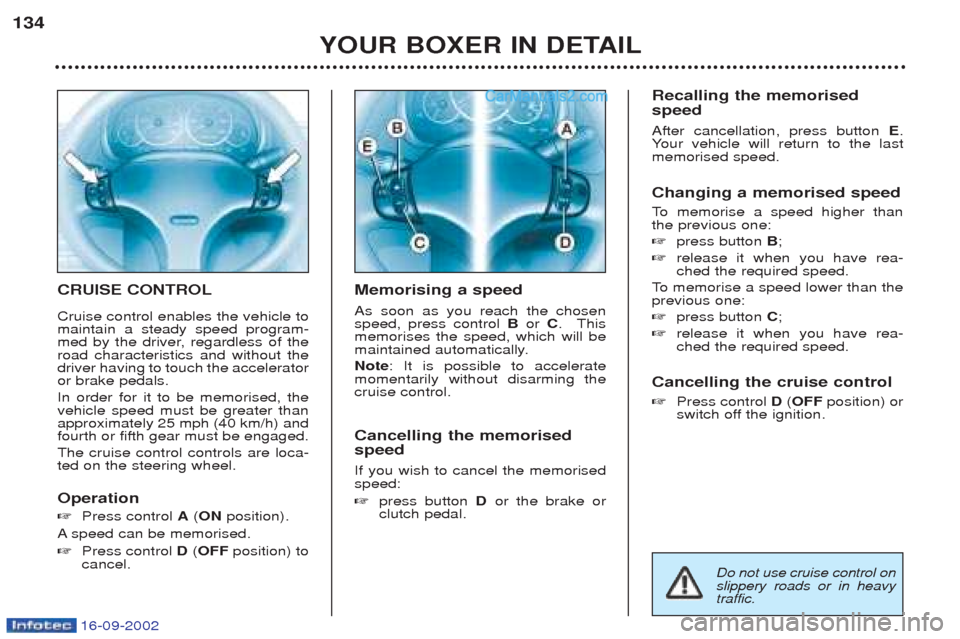
16-09-2002
CRUISE CONTROL Cruise control enables the vehicle to maintain a steady speed program-
med by the driver, regardless of theroad characteristics and without thedriver having to touch the acceleratoror brake pedals. In order for it to be memorised, the vehicle speed must be greater thanapproximately 25 mph (40 km/h) andfourth or fifth gear must be engaged. The cruise control controls are loca- ted on the steering wheel. Operation ☞Press control A(ON position).
A speed can be memorised.
☞ Press control D(OFF position) to
cancel. Memorising a speed As soon as you reach the chosen speed, press control
Bor C. This
memorises the speed, which will be
maintained automatically. Note : It is possible to accelerate
momentarily without disarming the cruise control. Cancelling the memorised speed If you wish to cancel the memorised speed: ☞ press button Dor the brake or
clutch pedal. Recalling the memorised speed After cancellation, press button
E.
Y our vehicle will return to the last
memorised speed. Changing a memorised speed
To memorise a speed higher than
the previous one: ☞ press button B;
☞ release it when you have rea- ched the required speed.
To memorise a speed lower than the
previous one: ☞ press button C;
☞ release it when you have rea- ched the required speed.
Cancelling the cruise control ☞ Press control D (OFF position) or
switch off the ignition.
YOUR BOXER IN DETAIL
134
Do not use cruise control on slippery roads or in heavytraffic.
Page 134 of 182

16-09-2002
YOUR BOXER IN DETAIL135
REAR PARKING ASSISTANCE This system consists of proximity
sensors, located in the rear bumper,and a special speaker fitted in thefascia. This detects any obstacle (person, vehicle, tree, gate, pavement etc.)behind the vehicle. Note:
this function will be disarmed
automatically when the vehicle is
towing a trailer.
In wintry weather, ensure that the sensors are not covered with frost or
snow.
Activation The system is activated as soon as reverse gear is engaged; an audiblebleep shows that it is active. The proximity information is given by an audible signal, which becomesmore rapid as the vehicle approachesthe obstacle. When the distance between the rear of the vehicle and the obstacle is lessthan approximately twenty centi-metres, the audible signal becomescontinuous.Deactivation ☞
Change to neutral, the system is again inactive.
Detection zone
If there is an operating fault, the audible signalwill be a short bleep follo-wed by a long bleep when
changing to reverse gear.
Page 135 of 182
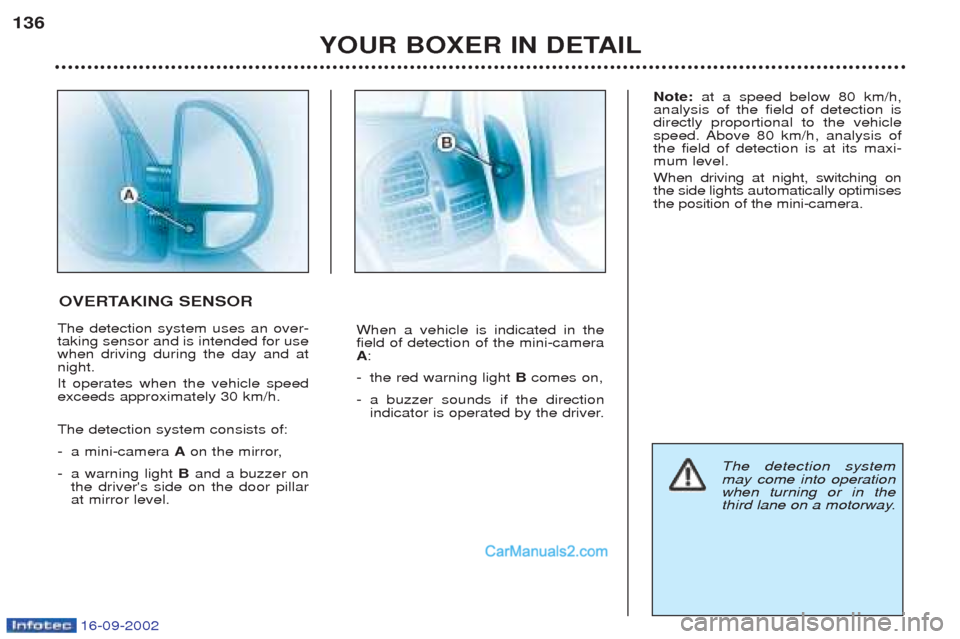
16-09-2002
YOUR BOXER IN DETAIL
136
The detection system uses an over- taking sensor and is intended for usewhen driving during the day and atnight. It operates when the vehicle speed exceeds approximately 30 km/h. The detection system consists of:
-a
mini-camera Aon the mirror,
-a warning light Band a buzzer on
the driver's side on the door pillar at mirror level. When a vehicle is indicated in thefield of detection of the mini-cameraA
:
- the red warning light Bcomes on,
- a buzzer sounds if the direction indicator is operated by the driver.
The detection system may come into operationwhen turning or in the
third lane on a motorway.
Note: at a speed below 80 km/h,
analysis of the field of detection is directly proportional to the vehicle
speed. Above 80 km/h, analysis ofthe field of detection is at its maxi-mum level. When driving at night, switching on the side lights automatically optimisesthe position of the mini-camera.
OVERTAKING SENSOR
Page 136 of 182
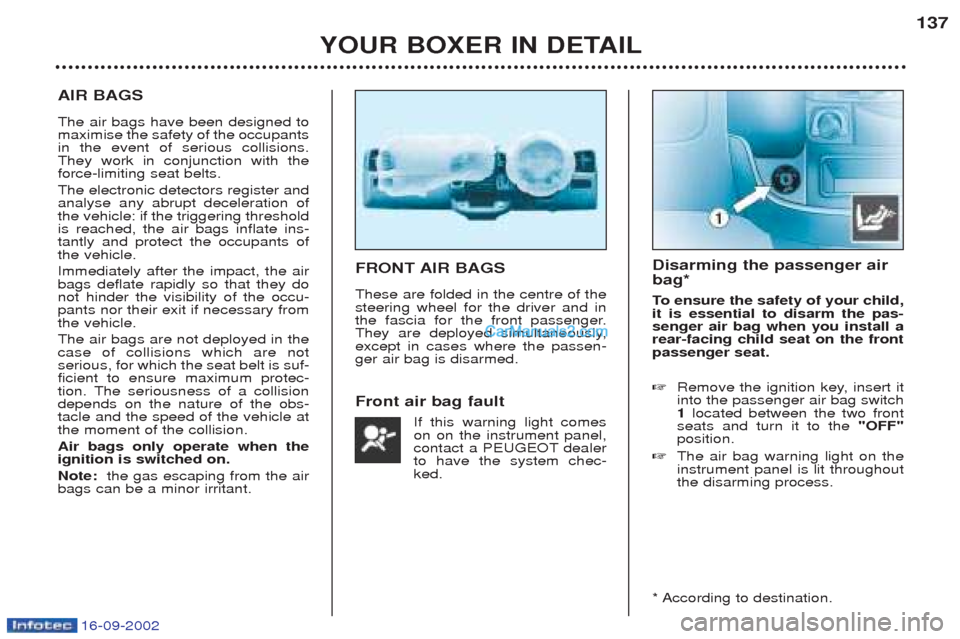
16-09-2002
YOUR BOXER IN DETAIL137
AIR BAGS The air bags have been designed to maximise the safety of the occupantsin the event of serious collisions.They work in conjunction with theforce-limiting seat belts. The electronic detectors register and analyse any abrupt deceleration ofthe vehicle: if the triggering thresholdis reached, the air bags inflate ins-tantly and protect the occupants ofthe vehicle. Immediately after the impact, the air bags deflate rapidly so that they donot hinder the visibility of the occu-pants nor their exit if necessary fromthe vehicle. The air bags are not deployed in the case of collisions which are notserious, for which the seat belt is suf-ficient to ensure maximum protec-
tion. The seriousness of a collisiondepends on the nature of the obs-tacle and the speed of the vehicle atthe moment of the collision. Air bags only operate when the ignition is switched on. Note:
the gas escaping from the air
bags can be a minor irritant. FRONT AIR BAGS These are folded in the centre of the steering wheel for the driver and in
the fascia for the front passenger.
They are deployed simultaneously,except in cases where the passen-ger air bag is disarmed. Front air bag fault
If this warning light comes on on the instrument panel,
contact a PEUGEOT dealerto have the system chec-ked. Disarming the passenger air bag*
To
ensure the safety of your child,
it is essential to disarm the pas- senger air bag when you install arear-facing child seat on the frontpassenger seat. ☞ Remove the ignition key, insert it into the passenger air bag switch1located between the two front
seats and turn it to the "OFF"
position.
☞ The air bag warning light on theinstrument panel is lit throughoutthe disarming process.
* According to destination.
Page 137 of 182
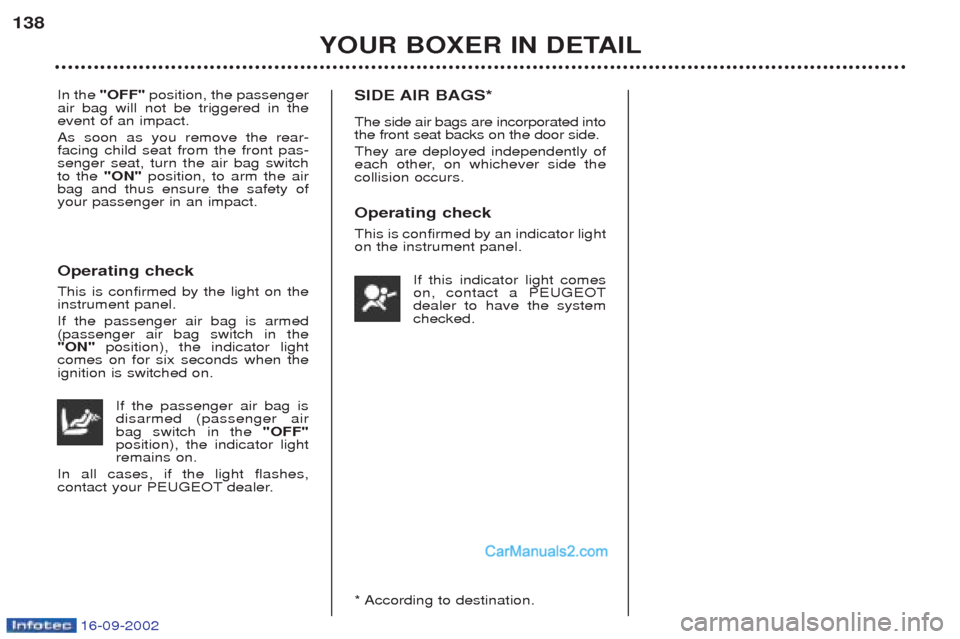
16-09-2002
YOUR BOXER IN DETAIL
138
In the
"OFF" position, the passenger
air bag will not be triggered in the event of an impact. As soon as you remove the rear- facing child seat from the front pas-senger seat, turn the air bag switchto the "ON"position, to arm the air
bag and thus ensure the safety ofyour passenger in an impact. Operating check This is confirmed by the light on the instrument panel. If the passenger air bag is armed (passenger air bag switch in the"ON" position), the indicator light
comes on for six seconds when theignition is switched on.
If the passenger air bag isdisarmed (passenger airbag switch in the "OFF"
position), the indicator lightremains on.
In all cases, if the light flashes,
contact your PEUGEOT dealer. SIDE AIR BAGS* The side air bags are incorporated into the front seat backs on the door side. They are deployed independently of
each other, on whichever side thecollision occurs. Operating check This is confirmed by an indicator light on the instrument panel.
If this indicator light comeson, contact a PEUGEOTdealer to have the systemchecked.
* According to destination.
Page 138 of 182
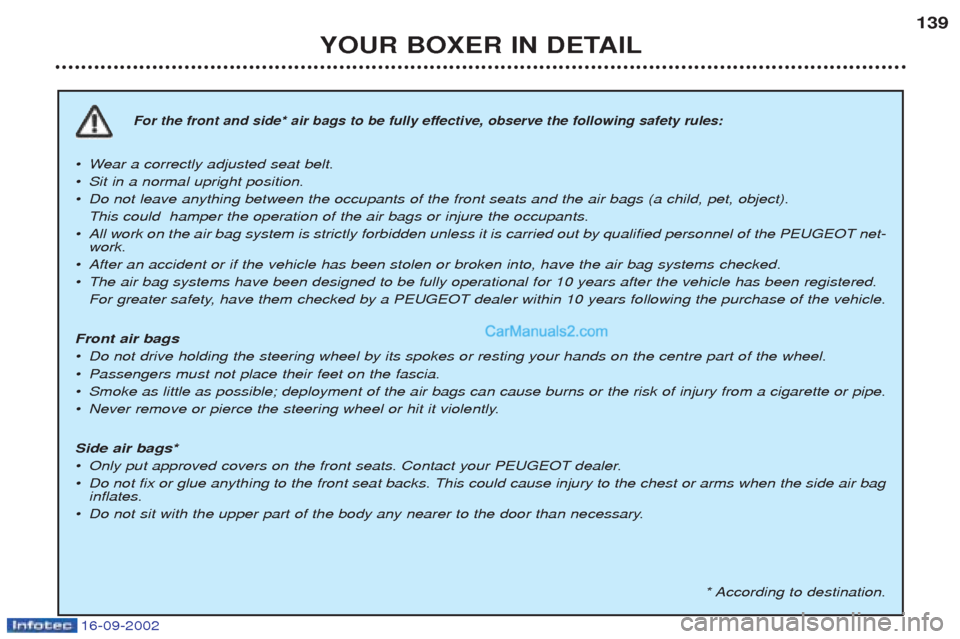
16-09-2002
YOUR BOXER IN DETAIL139
For the front and side* air bags to be fully effective, observe the following safety rules:
¥W
ear a correctly adjusted seat belt.
¥ Sit in a normal upright position.
¥ Do not leave anything between the occupants of the front seats and the air bags (a child, pet, object). This could hamper the operation of the air bags or injure the occupants.
¥ All work on the air bag system is strictly forbidden unless it is carried out by qualified personnel of the PEUGEOT net- work.
¥ After an accident or if the vehicle has been stolen or broken into, have the air bag systems checked.
¥ The air bag systems have been designed to be fully operational for 10 years after the vehicle has been registered.
For greater safety, have them checked by a PEUGEOT dealer within 10 years following the purchase of the vehicle.
Front air bags¥ Do not drive holding the steering wheel by its spokes or resting your hands on the centre part of the wheel.
¥ Passengers must not place their feet on the fascia.
¥ Smoke as little as possible; deployment of the air bags can cause burns or the risk of injury from a cigarette or pipe.
¥ Never remove or pierce the steering wheel or hit it violently.
Side air bags*¥ Only put approved covers on the front seats. Contact your PEUGEOT dealer.
¥ Do not fix or glue anything to the front seat backs. This could cause injury to the chest or arms when the side air bag inflates.
¥ Do not sit with the upper part of the body any nearer to the door than necessary.
* According to destination.
Page 139 of 182
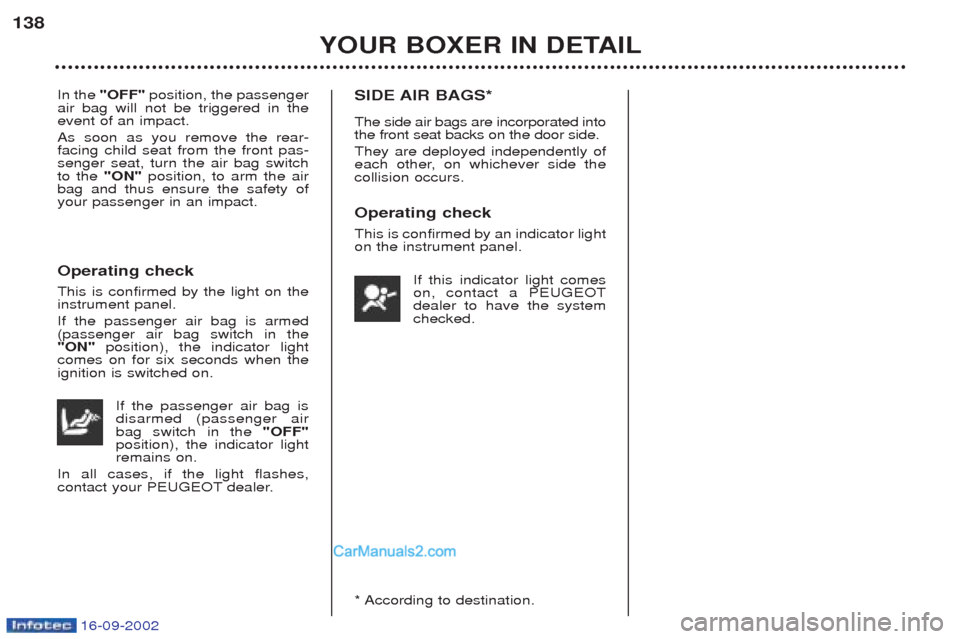
16-09-2002
YOUR BOXER IN DETAIL
138
In the
"OFF" position, the passenger
air bag will not be triggered in the event of an impact. As soon as you remove the rear- facing child seat from the front pas-senger seat, turn the air bag switchto the "ON"position, to arm the air
bag and thus ensure the safety ofyour passenger in an impact. Operating check This is confirmed by the light on the instrument panel. If the passenger air bag is armed (passenger air bag switch in the"ON" position), the indicator light
comes on for six seconds when theignition is switched on.
If the passenger air bag isdisarmed (passenger airbag switch in the "OFF"
position), the indicator lightremains on.
In all cases, if the light flashes,
contact your PEUGEOT dealer. SIDE AIR BAGS* The side air bags are incorporated into the front seat backs on the door side. They are deployed independently of
each other, on whichever side thecollision occurs. Operating check This is confirmed by an indicator light on the instrument panel.
If this indicator light comeson, contact a PEUGEOTdealer to have the systemchecked.
* According to destination.
Page 140 of 182
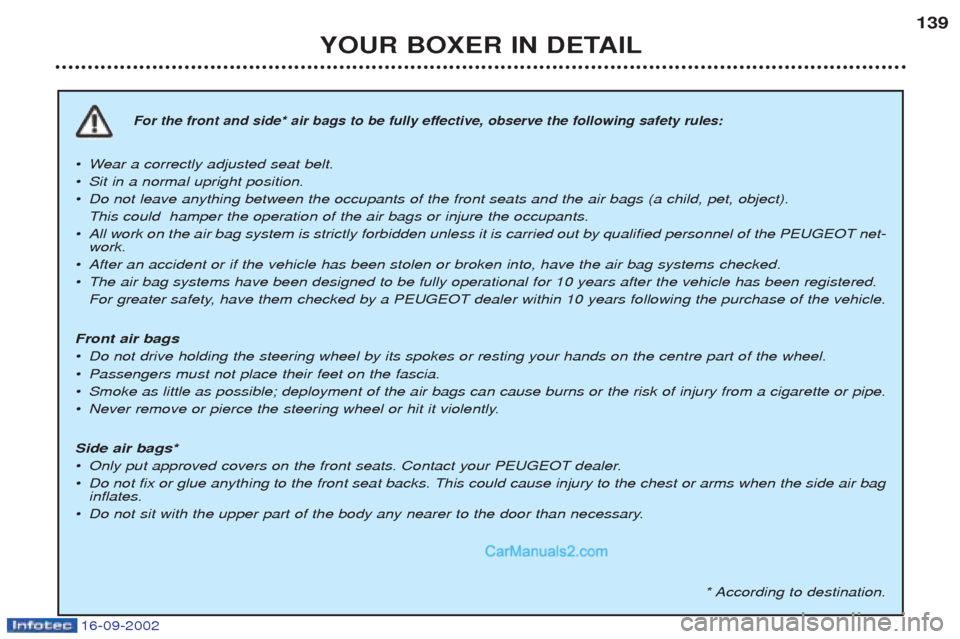
16-09-2002
YOUR BOXER IN DETAIL139
For the front and side* air bags to be fully effective, observe the following safety rules:
¥W
ear a correctly adjusted seat belt.
¥ Sit in a normal upright position.
¥ Do not leave anything between the occupants of the front seats and the air bags (a child, pet, object). This could hamper the operation of the air bags or injure the occupants.
¥ All work on the air bag system is strictly forbidden unless it is carried out by qualified personnel of the PEUGEOT net- work.
¥ After an accident or if the vehicle has been stolen or broken into, have the air bag systems checked.
¥ The air bag systems have been designed to be fully operational for 10 years after the vehicle has been registered.
For greater safety, have them checked by a PEUGEOT dealer within 10 years following the purchase of the vehicle.
Front air bags¥ Do not drive holding the steering wheel by its spokes or resting your hands on the centre part of the wheel.
¥ Passengers must not place their feet on the fascia.
¥ Smoke as little as possible; deployment of the air bags can cause burns or the risk of injury from a cigarette or pipe.
¥ Never remove or pierce the steering wheel or hit it violently.
Side air bags*¥ Only put approved covers on the front seats. Contact your PEUGEOT dealer.
¥ Do not fix or glue anything to the front seat backs. This could cause injury to the chest or arms when the side air bag inflates.
¥ Do not sit with the upper part of the body any nearer to the door than necessary.
* According to destination.